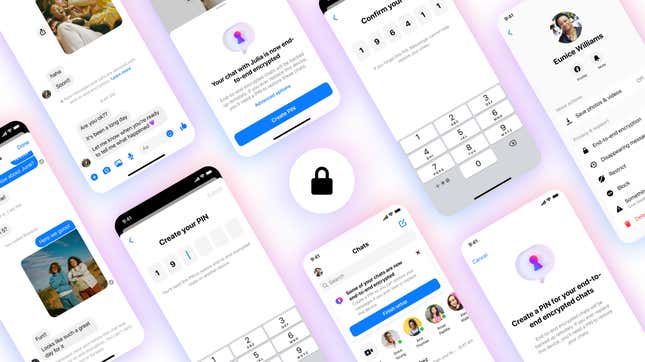
Meta might not be a bastion of digital privacy (and very well may be an enemy of it), but the times might be a-changin’. Last summer, the company announced it is testing end-to-end encryption (E2EE) for Facebook Messenger as the default, meaning all Messenger users would have their chats protected from spying eyes unless they choose not to. A fresh announcement this week, on Jan. 23, confirms these tests are expanding, which means you may soon be able to enjoy the protections of E2EE on your Messenger app without doing a thing.
But until that happens, it’s pretty easy to enable E2EE in Messenger right now. Here’s how to do it.
How end-to-end encryption works
With typical messaging, texts are stored openly on your device, the device you send them to, and the server of the messaging platform (i.e. Facebook Messenger itself). Those messages can be read by anyone with access to the devices where those messages are stored, including the hosts of the messaging platform. That makes it easy for a company like Meta to hand over your messages to an authority, should such a request come through.
With end-to-end encryption, however, messages aren’t sent and stored in plain text, but rather they’re “scrambled.” If you were to try to read an encrypted message, it would appear as an unrecognizable jumble of characters, making it useless to intercept.
To unscramble the message, you need a “key.” For messaging purposes, that key is either your device or the recipient’s device. Those two devices are the only devices capable of unscrambling your particular conversation—even though Meta is facilitating the passage of these messages, it has no way to unscramble the messages for itself or anyone who comes asking for them.
Meta is testing E2EE as the default messaging protocol for all conversations in Messenger, which would offer these benefits to all users out of the box. While the initial tests only included a few hundred users, Meta has expanded the pool of testers as of Monday, Jan. 23. However, chances are your chats still aren’t E2EE yet, and you probably need to enable them yourself.
How to enable end-to-end encryption in Facebook Messenger
This hidden feature is called “secret conversation,” and it’s fairly straightforward to use (albeit a bit buried). To start, open a chat you’d like E2EE for, then tap the person or group name at the top of the display. Under “More actions,” tap “Go to secret conversation” or “Start end-to-end encrypted chat,” and Messenger will instantly open up a new E2EE chat.
The catch is that the other user needs to be using a device and Messenger app that is compatible with secret conversations and E2EE. If they aren’t, you’ll get an error message when you try to send anything in a secret conversation.
E2EE used to be quite limited on Messenger. You’d get a simple black and white theme to denote the special nature of the chat, all without the usual bells and whistles you’d expect from a Messenger chat. However, thanks to a recent update, you can access many of the usual Messenger features, like chat themes, custom emojis and reactions, group chats, group pictures, link previews, active status, and chat bubbles (Android only).
That said, there are still some limitations as of this article. You can’t make audio or video calls, encrypt large groups, or send payments just yet. Still, we’re making major E2EE progress in Messenger. Just keep in mind, you’ll see two chats in your app for each contact you started a secret conversation with. Make sure you tap on the thread with the lock icon, not the normal conversation, if you want your messages protected. Once E2EE is fully rolled out, I expect this won’t be a problem.
